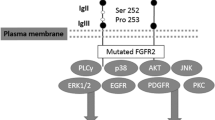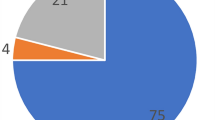Abstract
Background
Craniosynostosis is the premature closure of cranial sutures and it continues to be a therapeutic challenge due to the diversity and complexity of the syndrome. Bibliometric analysis is a study of ranking citations and exploring the most impactful articles in a respective discipline. It also demonstrates the chronological trends of publications.
Methods
In May 2020, we performed a title-specific search of the Scopus database using “craniosynostosis” as our query term without publication date restrictions. The top 100 articles in craniosynostosis were retrieved and analyzed.
Results
The top 100 most-cited articles in craniosynostosis received a total 13,826 citations, and an average of 138 citations per paper. The publication dates ranged from 1920 to 2015, with a peak period of top publications between 1996 and 2005. The most common category is clinical, followed by neurogenetics. The top cited article received 540 citation counts and 19.29 citations per year. The USA was the most contributing country to the list. The Journal of Plastic and Reconstructive Surgery published the largest number of top cited articles. Neurosurgery as a specialty contributed to most articles in the list (27 articles). The institute who contributed the most was the Assistance Publique Hopitaux Paris.
Conclusion
Bibliometric analysis in craniosynostosis revealed major trend changes of research over the years, with a focus on neurogenetics and the different types of surgical corrections. The current collection of highly cited publications may assist physicians in gaining a better understanding of the evidence-based approach in craniosynostosis.






Similar content being viewed by others
Data Availability
Not applicable.
Abbreviations
- H-Index:
-
Hirsch index
- SNIP:
-
Journal’s Source Normalized Impact Per Paper
- SJR:
-
Journal’s SCImago Journal Rank
- IF:
-
Journal impact factor
- CC:
-
Citation count
- CY:
-
Citation per year
- RCT:
-
Randomized controlled trial
References
Alfaifi A, AlMutairi O, Allhaidan M, Alsaleh S, Ajlan A (2018) The top 50 most-cited articles on acoustic neuroma. World Neurosurg 111:e454–e464. https://doi.org/10.1016/j.wneu.2017.12.090
Almutairi O, Albakr A, Al-Habib A, Ajlan A (2017) The top-100 most-cited articles on meningioma. World Neurosurg 107:1025–1032
Boulet SL, Rasmussen SA, Honein MA (2008) A population-based study of craniosynostosis in metropolitan Atlanta, 1989–2003. J Med Genet Part A 146:984–991
Cohen MM Jr (1993) Sutural biology and the correlates of craniosynostosis. Am J Med Genet 47:581–616
Dadure C, Sauter M, Bringuier S, Bigorre M, Raux O, Rochette A, Canaud N, Capdevila X (2011) Intraoperative tranexamic acid reduces blood transfusion in children undergoing craniosynostosis surgery: a randomized double-blind study. Anesthesiology 114:856–861
Di Rocco F, Arnaud E, Renier D (2009) Evolution in the frequency of nonsyndromic craniosynostosis. J Neurosurg Pediatr 4:21–25
Garner RM, Hirsch JA, Albuquerque FC, Fargen KM (2018) Bibliometric indices: defining academic productivity and citation rates of researchers, departments and journals. J Neurointerv Surg 10:102–106
Guo X, Gao L, Wang Z, Feng C, Xing B (2018) Top 100 most-cited articles on pituitary adenoma: a bibliometric analysis. World Neurosurg 116:e1153–e1167. https://doi.org/10.1016/j.wneu.2018.05.189
Iftikhar PM, Ali F, Faisaluddin M, Khayyat A, De Gouvia De Sa M, Rao T (2019) A bibliometric analysis of the top 30 most-cited articles in gestational diabetes mellitus literature (1946–2019). Cureus 11
Jabs EW, Müller U, Li X, Ma L, Luo W, Haworth IS, Klisak I, Sparkes R, Warman ML, Mulliken JB, Snead ML, Maxson R (1993) A mutation in the homeodomain of the human MSX2 gene in a family affected with autosomal dominant craniosynostosis. Cell 75:443–450
Jimenez DF, Barone CM (1998) Endoscopic craniectomy for early surgical correction of sagittal craniosynostosis. J Neurosurg 88:77–81
Jusue-Torres I, Hulbert A, Germanwala AA, Patel CR, Germanwala AV (2018) The 100 Most-cited reports about Craniopharyngioma. World Neurosurg 119:910–921
Kane AA, Mitchell LE, Craven KP, Marsh JL (1996) Observations on a recent increase in plagiocephaly without synostosis. Pediatrics 97:877–885
Kearney RA, Rosales JK, Howes WJ (1989) Craniosynostosis: an assessment of blood loss and transfusion practices. Can J Anaesth 36:473–477
Kimonis V, Gold JA, Hoffman TL, Panchal J, Boyadjiev SA (2007) Genetics of craniosynostosis. Semin Pediatr Neurol 14:150–161
MacRoberts MH, MacRoberts BR (2010) Problems of citation analysis: a study of uncited and seldom-cited influences. J Am Soc Inf Sci Technol 61:1–12
Muenke M, Gripp KW, McDonald-McGinn DM, Gaudenz K, Whitaker LA, Bartlett SP, Markowitz RI, Robin NH, Nwokoro N, Mulvihill JJ, Losken HW, Mulliken JB, Guttmacher AE, Wilroy RS, Clarke LA, Hollway G, Adès LC, Haan EA, Mulley JC, Cohen MM Jr, Bellus GA, Francomano CA, Moloney DM, Wall SA, Wilkie AO (1997) A unique point mutation in the fibroblast growth factor receptor 3 gene (FGFR3) defines a new craniosynostosis syndrome. Am J Hum Genet 60:555–564
Persson KM, Roy WA, Persing JA, Rodeheaver GT, Winn HR (1979) Craniofacial growth following experimental craniosynostosis and craniectomy in rabbits. J Neurosurg 50:187–197
Shillito J Jr, Matson DD (1968) Craniosynostosis: a review of 519 surgical patients. Pediatrics 41:829–853
Shuper A, Merlob P, Grunebaum M, Reisner SH (1985) The incidence of isolated craniosynostosis in the newborn infant. Am J Dis Child 139:85–89
Tahim A, Patel K, Bridle C, Holmes S (2016) The 100 most cited articles in facial trauma: a bibliometric analysis. J Oral Maxillofac Surg 74:2240
Tahiri Y, Fleming TM, Greathouse T, Tholpady SS (2015) Analysis of the 50 most cited papers in craniofacial surgery. J Cranio-Maxillofacial Surg 43:2152–2157
Taylor WJ, Hayward RD, Lasjaunias P, Britto JA, Thompson DNP, Jones BM, Evans RD (2001) Enigma of raised intracranial pressure in patients with complex craniosynostosis: the role of abnormal intracranial venous drainage. J Neurosurg 94:377–385
Weinzweig J, Kirschner RE, Farley A, Reiss P, Hunter J, Whitaker LA, Bartlett SP (2003) Metopic synostosis: defining the temporal sequence of normal suture fusion and differentiating it from synostosis on the basis of computed tomography images. Plast Reconstr Surg 112:1211–1218
Wilkie AO (1997) Craniosynostosis: genes and mechanisms. Hum Mol Genet 6:1647–1656
Yu HM, Jerchow B, Sheu TJ, Liu B, Costantini F, Puzas JE, Birchmeier W, Hsu W (2005) The role of Axin2 in calvarial morphogenesis and craniosynostosis. Development 132:1995–2005
Zhang X, Kuroda S, Carpenter D et al (2002) Craniosynostosis in transgenic mice overexpressing Nell-1. J Clin Invest 110:861–870
Author information
Authors and Affiliations
Corresponding author
Ethics declarations
Conflict of interests
None.
Code availability
Not applicable.
Additional information
All figures were made using the Visme software.
Publisher’s note
Springer Nature remains neutral with regard to jurisdictional claims in published maps and institutional affiliations.
Rights and permissions
About this article
Cite this article
Elarjani, T., Almutairi, O.T., Alhussinan, M. et al. Bibliometric analysis of the top 100 most cited articles on craniosynostosis. Childs Nerv Syst 37, 587–597 (2021). https://doi.org/10.1007/s00381-020-04858-2
Received:
Accepted:
Published:
Issue Date:
DOI: https://doi.org/10.1007/s00381-020-04858-2




